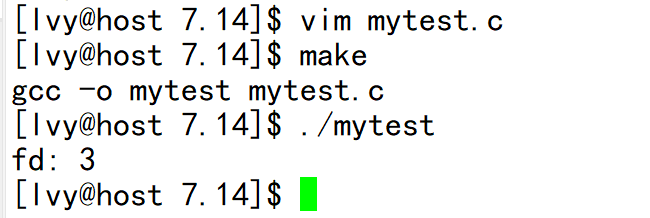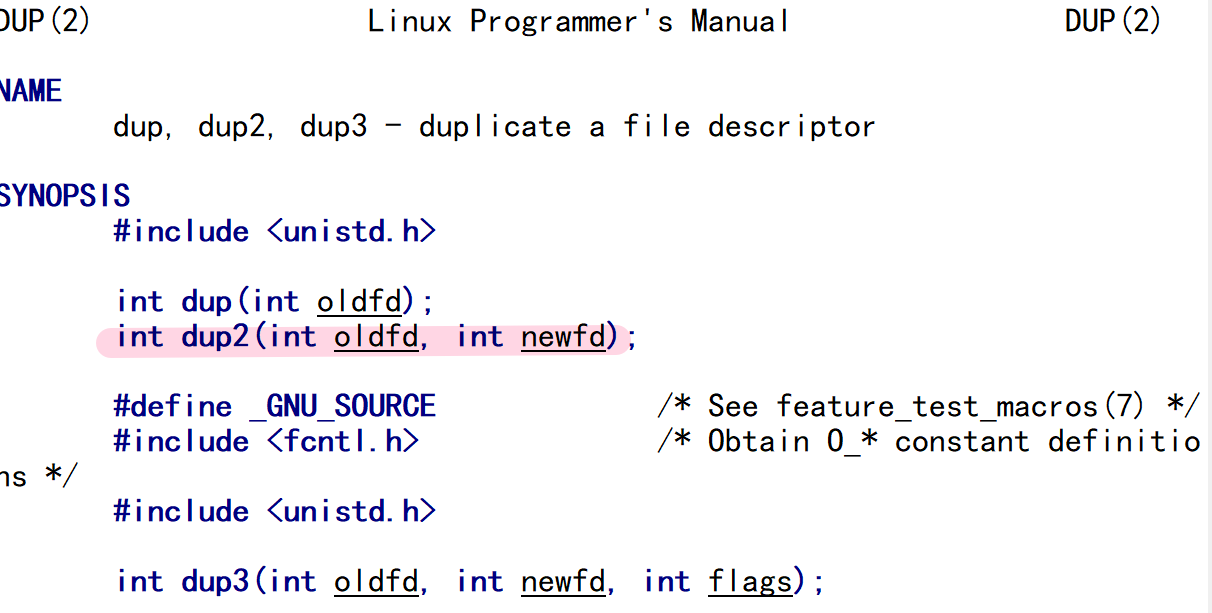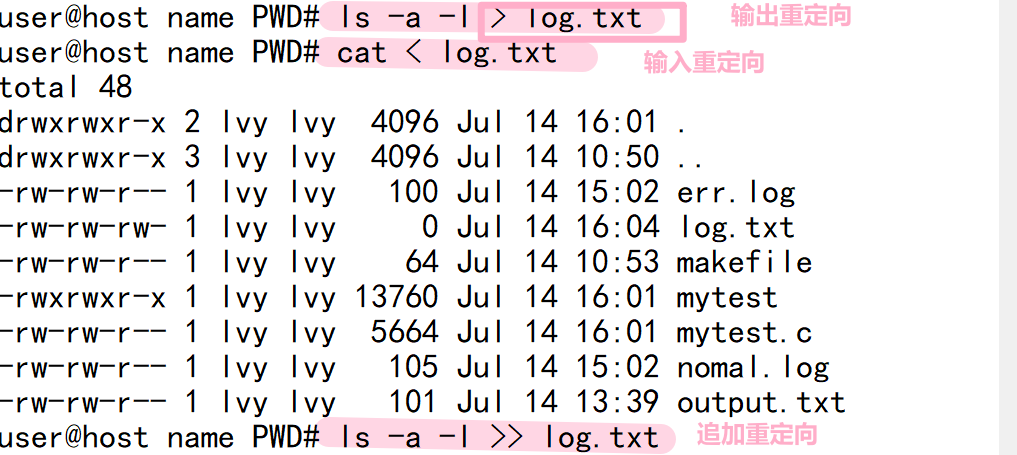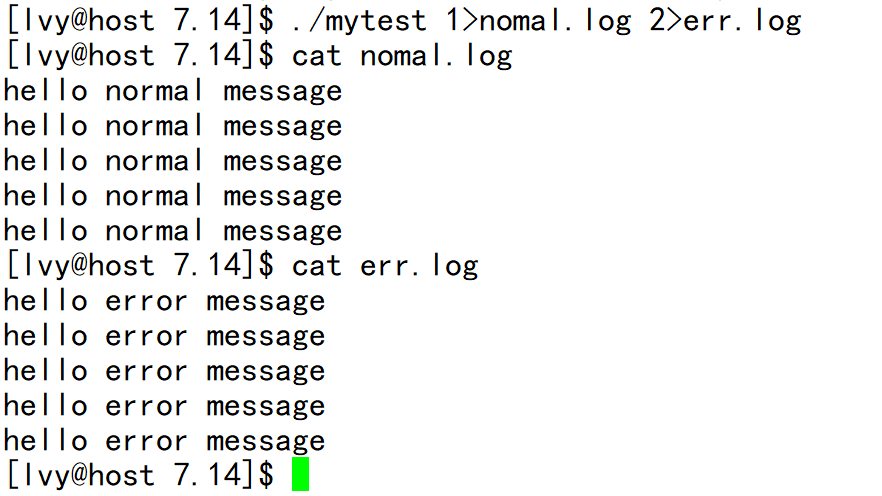目录
前言
1.文件描述符分配规则
2.dup2 重定向接口
3.重定向
3.1>输出重定向
3.2>>追加重定向
3.3<输入重定向
3.4 shell 模拟实现< >
3.5 理解>
4. 理解“Linux 下一切皆文件”
前言
问:fd 为什么默认从 3 开始,而不是从 0,1,2?
💬 前面还存在默认标准文件,stdin, stdout, stderr ,和 0,1,2一一对应
验证:
int fd = open("log.txt", O_WRONLY | O_CREAT | O_TRUNC, 0666);

❗ 从 0 下标开始,寻找最小的没有使用的数组位置,它的下标就是新文件的文件描述符
(1) 关闭0,对返回的 fd 进行测试
int fd = open("log.txt", O_WRONLY | O_CREAT | O_TRUNC, 0666);
运行:

(2)关闭 1
int fd=open("log.txt",O_WRONLY|O_CREAT|O_TRUNC,0666);
//这里必须刷新一下,不然log.txt里面没有内容,这里和缓冲区有关,下面讲
运行;

❓ 本来应该直接打到显示器上的消息,打印到了 log.txt 上,是为什么呢?
A: 进程不 care 1 文件发生的变化,先关闭再 open,根据验证规则,会实现对 1 文件的补充重定向

❗ 重定向的本质:上层用的 fd 不变,在内核中更改 fd 对应的 struct file* 地址
2.dup2 重定向接口
man dup2

NAME 中提到:dup 复制文件描述符
函数功能:
dup2函数将
文件描述符oldfd复制到newfd,并返回一个新的
文件描述符。如果newfd已经打开,则将先
关闭它。新的
文件描述符将继承oldfd的
文件状态标志(例如,
文件偏移量、
文件访问模式等)。
函数返回值:
成功时,返回新的
文件描述符;失败时,返回-1,并
设置errno变量来指示错误类型。

具体应用: new be old ,新的被老的覆盖,所以保留的是 old,dup2(old, new),所以前一个文件会拷贝形成 double 份,如果想实现对之前操作的实现,即 dup2(fd,1)
tIP: 拷贝的是下标指针 struct 的 拷贝替换
int fd=open("log.txt",O_WRONLY|O_CREAT|O_TRUNC,0666);
//这里必须刷新一下,不然log.txt里面没有内容
运行:

fd 覆盖了 log,应该输出到 1 中的,就到 fd 文件里面了
3.重定向
3.1>输出重定向
上面内容就是输出重定向,把新打开文件的fd重定向到fd为1(默认为显示器)的位置。
3.2>>追加重定向
实现在文件原内容后面的添加
// int fd=open("log.txt",O_WRONLY|O_CREAT|O_TRUNC,0666);
int fd=open("log.txt",O_WRONLY|O_CREAT|O_APPEND,0666);
//这里必须刷新一下,不然log.txt里面没有内容

3.3<输入重定向
测试:
// int fd=open("log.txt",O_WRONLY|O_CREAT|O_TRUNC,0666);
// int fd=open("log.txt",O_WRONLY|O_CREAT|O_APPEND,0666);
int fd=open("log.txt",O_RDONLY);
if(fgets(outbuffer,sizeof(outbuffer),stdin) == NULL) break;
输入重定向:
使用
dup2(fd, 0) 将
文件描述符
fd 重定向到
标准输入(
文件描述符0),即从此
程序的
标准输入将从
log.txt 读取。
读取并输出内容:
声明一个字符数组
outbuffer[64] 用于
存储从
标准输入读取的内容。使用
while 循环不断读取
标准输入(现在是
log.txt 的内容)直到
文件结束。
printf("<") 打印一个提示符。
fgets(outbuffer, sizeof(outbuffer), stdin) 从
标准输入读取一行,如果读取失败(例如
文件结束),则退出循环。
printf("%s", outbuffer) 将读取的内容打印到
标准输出。
❗ fgets(stdin)的显示,由键盘变为了从文件中读取,后并打印
C++联动:
>输入(将内容添加到文件之中),<读取(由从键盘读取变为了从某文件读取 fgets 0->fgets file)
3.4 shell 模拟实现< >
思路:
头文件
void check_redir(char *cmd);
void interact(char *cline, int size);
void NormalExcute(char *_argv[]);
check_redir:
该函数处理命令字符串以
识别和处理输入(
<)、输出(
>)和追加(
>>)重定向。它
更新命令字符串以排除重定向部分,并相应地
设置全局变量
rdirfilename 和
rdir。
void check_redir(char *cmd) {
if (*pos == >) {//查找重定向符号,对之后实现替换
if (*(pos + 1) == >) {//追加重定向
while (isspace(*pos)) pos++;//后面的判断怎么理解呢
rdirfilename
= pos;
//将
文件名赋给
rdir
= APPEND_RDIR;
//命令行
操作
while (isspace(*pos)) pos++;
*pos = \0; // ls -a -l -n < filename.txt
while (isspace(*pos)) pos++;
interact:
该函数提示
用户输入,获取命令行,并调用
check_redir 处理任何重定向。
void interact(char *cline, int size) {
getpwd();
//获取当前工作
目录并打印提示符
printf(LEFT"%s@%s %s"RIGHT""LABLE" ", getusername(), gethostname1(), pwd);
char *s = fgets(cline, size, stdin);//获取命令行输入
cline[strlen(cline) - 1] = \0;//移除换行符
check_redir(cline);//处理重定向符号
NormalExcute:
该函数
创建一个新进程来执行给定的命令。如果
设置了任何重定向,它会在执行命令之前相应地调整
文件描述符。
// Function to execute commands
void NormalExcute(char *_argv[]) {
if (rdir
== IN_RDIR) {
//对标记的rdir进行
操作判断
fd = open(rdirfilename, O_RDONLY);
} else if (rdir == OUT_RDIR) {
fd = open(rdirfilename, O_CREAT | O_WRONLY | O_TRUNC, 0666);
} else if (rdir == APPEND_RDIR) {
fd = open(rdirfilename, O_CREAT | O_WRONLY | O_APPEND, 0666);
pid_t rid = waitpid(id, &status, 0);
lastcode = WEXITSTATUS(status);
main:
程序的主循环初始化重定向
设置,与
用户交互以获取命令,将命令行输入分割成参数,并调用
NormalExcute 执行命令。
interact(commandline, sizeof(commandline));
// Tokenize the command line input into arguments
char *token = strtok(commandline, " ");
token = strtok(NULL, " ");
占位符函数:
getpwd、
getusername 和
gethostname1 是用于获取当前工作
目录、
用户名和主机名的占位符函数,应根据需要实现实际
功能。
// Implement function to get current working directory
// Implement function to get the username
// Implement function to get the hostname
运行:

思考:
问:后面我们做了重定向的工作,后面我们在进行程序替换的时候,难道不影响吗???
不影响
❗ 程序替换,和文件访问是并列的关系,mm_struct && file_struct ,程序替换,只会替换代码和数据,不影响曾经打开的重定向文件
联系:可以通过对文件调动,为进程替换提供良好的环境
问:子进程重定向会影响父进程吗?
不会
❗ 子进程会对父进程进行写实拷贝
3.5 理解>
#define filename "log.txt"
fprintf(stdout, "hello normal message\n");
fprintf(stdout, "hello normal message\n");
fprintf(stdout, "hello normal message\n");
fprintf(stdout, "hello normal message\n");
fprintf(stdout, "hello normal message\n");
fprintf(stderr, "hello error message\n");
fprintf(stderr, "hello error message\n");
fprintf(stderr, "hello error message\n");
fprintf(stderr, "hello error message\n");
fprintf(stderr, "hello error message\n");
测试:
./mytest 1>nomal.log 2>err.log
./mytest 1>all.log 2>&1 //实现了覆盖

>默认指向的是 1,那 2 的设置有什么意义呢?
意义: 将错误信息和正确信息分开放了,便于程序员的查看
❗ 对于重定向的记忆
cat(cout)<<输出
>>(cin)输入到
和原理毫不相关,就是用着发现这样挺好记忆的

🔔 进程通过对文件的管理实现了对设备的管理,设备的信息其实也是以文件的形式存储了
这里可能有这样一个问题,如果同一个文件被多个指针指向,但是某个进程把这个文件关了,会不会影响其他进程对这个文件的操作呢?
A: 其实并不会,一个被打开的文件有引用计数。
表明有几个指针指向这个文件,这样做是因为一个文件可能被多个指针指向。如果某个进程关闭文件,影响到其他进程,就不能保证进程的独立性。close关闭文件,其实并不是真正关闭文件,只是把引用计数减1,当只有一个指针指向这个文件,close关闭文件才是真正关闭这个文件。
文件有*write file 指针,屏蔽掉了设备的差异化,通过指针指向//C++联想:多态,奇类,派生类
思考:
1. 面向对象,是历史的必然,是先进的表现
2. 万变不离其宗:
学习了底层知识,就可以是我们面对各种语言进行文件读取时,读读文档,就能上手操作了
学习思考:通过不断的实验和提问,来进行学习





















